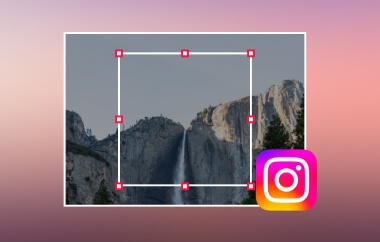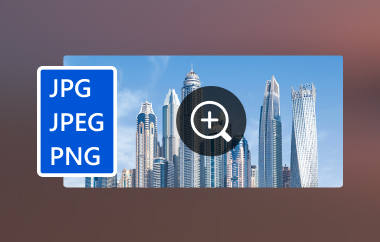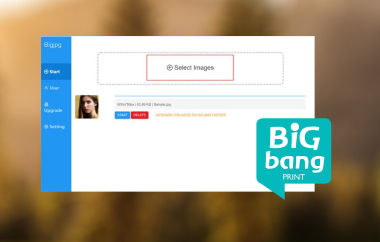Did your JPG files pile up? Most of them are so big in file size that you aren’t aware they are eating up too much storage on your device. In the worst case, it can also be one of the causes of your computer lagging or acting up. Yes, even a mismanagement of simple files such as JPG could lead to greater damage. The good thing is that it is not a new problem, meaning there are now ways to address this issue. You can use tools such as image compressors to help you reduce the file size of your JPG files.
That said, this post will give you demonstrations of how to make a JPEG smaller using effective tools online. Check them out below to learn more.
Part 1. What is JPEG/JPG
JPEG, which stands for Joint Photographic Experts Group, is a widely recognized format for digital images. When you see files ending in .jpg or .jpeg, that's the JPEG format at work. It's trendy due to its clever use of lossy compression. An approach that shrinks the file's size by subtly eliminating some of the image data. While this might sound like you're losing out, it's actually a handy feature because it lets you strike a balance between image quality and how much space the image takes up on your device. You can opt for high compression to save space, which is great for sharing pictures online, but this might make the image a bit grainy. If you keep the compression low, you'll have a better-looking photo that takes up more room.
Because of its flexibility and ease of use, JPG has become the go-to format for most of us snapping pictures, especially with smartphones. It's supported on practically every device imaginable and by tons of software, which makes it a breeze to view, edit, and share your memories without worrying about compatibility issues. This format is a real workhorse—it gives us decent image quality without hogging all our storage, and it makes uploading to social media or sending to friends quick and effortless. Despite the fact that each time you compress a JPEG, you lose a bit of detail, for the everyday user, it often strikes just the right balance.
Part 2. Best Way to Compress JPEG/JPG
When compressing photos, it's important to balance reducing the file size and maintaining acceptable image quality for your needs. This is what AVAide Image Compressor is developed for. The program operates on the web, meaning you can compress your photos from a browser directly. Additionally, it is compatible with almost any browser without any problem. What is impressive is that it automatically shrinks photos after uploading your JPG files onto the program. On top of that, you compress various formats in batches. Therefore, you can leave the work to this program while having your cup of coffee.
To learn how to shrink JPEG file size, look into the step-by-step procedure below:
Step 1First of all, access the program using any browser on your computer. Once you land on the page, you should see the upload button that looks like a big plus. Tick the Choose Files button and select the photos you wish to compress.
Step 2Upon uploading the photos, the tool will immediately shrink the file without you even ticking a button. You will see the shrink level and notice that it does not shrink to the extent of losing the quality.
Step 3Finally, hit the Download All button below the shrunk photos to save them on your computer.
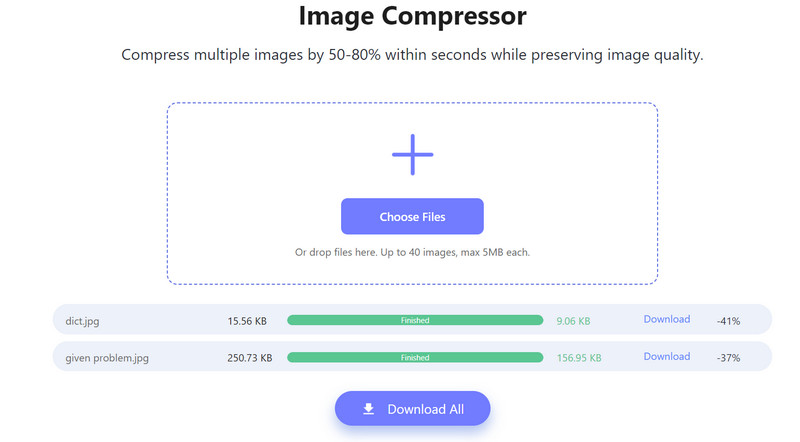
Part 3. Other Useful Ways to Compress JPG Pictures
There are other tools available for compressing photos, often used to reduce file size for easier sharing or storage. Some popular photo compression tools are:
Adobe Photoshop
Adobe Photoshop really excels in giving you control over photo compression. It's packed with features that let pros tweak every pixel to perfection. You can hop into Save for Web if you want a quick way to smash down file sizes for the internet - handy sliders let you adjust quality, and you can mess with formats like JPEG, PNG, and GIF until you hit that sweet spot between crisp visuals and lean file size. There's more under the hood, too. You can resize images, play with color optimization, and even get a sneak peek at what the result will look like before you commit. It's that kind of muscle that makes Photoshop the go-to for artists and designers who need their pictures to pop online without dragging download times. Here is the instruction on how to shrink file size using Photoshop:
Step 1First, fire up Photoshop and pull up the image you want to shrink. Once it's there, staring back at you, head up to the File menu and click Export, then choose the Save for Web option.
Step 2This pulls up a new window where the magic happens. You’ll see your picture alongside a bunch of settings that might look a tad intimidating at first, but they’re pretty straightforward.
Step 3Now, if you look for the dropdown box that's labeled Preset, you can pick the type of file you want—JPEG is a solid bet for photos. Just below that, there’s a Quality slider that you can nudge left or right. There you have it. You have just optimized JPEG to reduce the file size or upload it online.
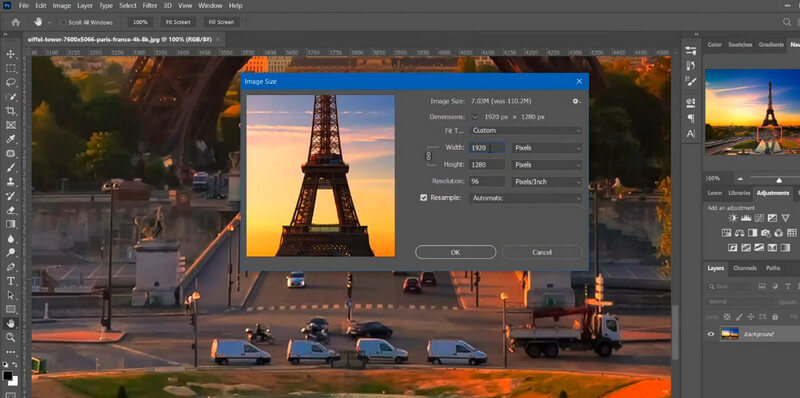
TinyPNG
This web service takes your bulky PNGs that also work for JPEG and compresses them behind the scenes so they are web-ready. What’s cool is that it manages to make files smaller without a noticeable quality drop. The interface? Super simple. Just drag and drop your files and watch TinyPNG do its thing. Plus, you can toss up to 20 images at it in one go, which is a real time-saver. It's perfect for web designers who need to speed up page loads without sacrificing looks or bloggers trying to keep their site quick on its feet. Let's walk through using TinyPNG to compress JPEG size online into something more manageable, internet-style.
Step 1You'll want to start by surfing over to the TinyPNG website. There's no need to sign up for anything or download stuff; it's all happening right there in your browser.
Step 2Grab the JPGs you want to slim down straight from their folder, and just drag and drop them onto the page. TinyPNG will then chomp on your files, squeezing out all the extra bytes it can without making your images look crummy.
Step 3Once it's done, you'll see a list of your compressed photos along with how much weight they've lost. Now, just hit the Download All button next to each image to save your newly slimmed-down JPGs, or snatch them all at once in a zippy ZIP file.
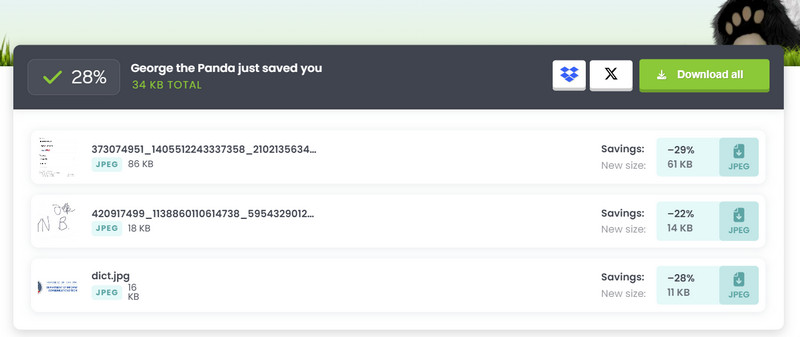
GIMP
GIMP is the trusty Swiss Army knife of image editing, and it's free to boot. It stands for GNU Image Manipulation Program, and as the name suggests, it's chock-full of features for tweaking and editing graphics.
Step 1To squeeze those JPEGs without making them look like a blocky mess, you just open up GIMP, haul your image into it, and then when you're done sprucing it up, you head over to File, then Export As.
Step 2Here's where the magic happens. You can pick JPEG as your format, slam that Export button, and GIMP will pop open some options.
Step 3Slide left for a smaller file, right for better quality. Once you've found the sweet spot, hit Export. You've got yourself a compressed JPEG, ready to roll out onto the web or wherever you need it to go.
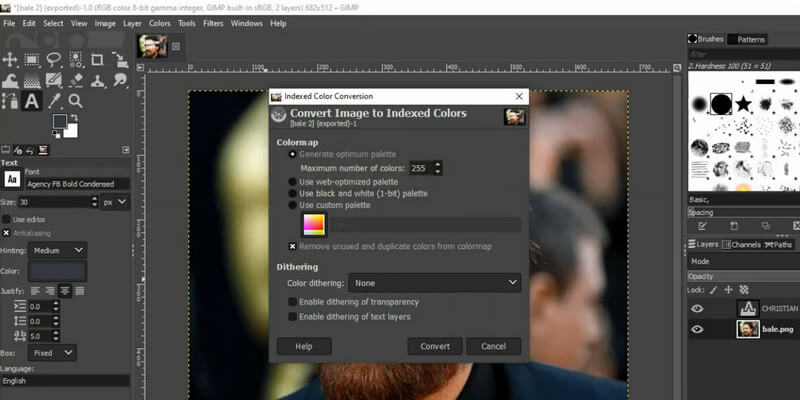
ImageOptim
A tool available for macOS users that provides drag-and-drop image compression is ImageOptim. It's all about making your images web-ready without a fuss. It strips out all the invisible junk, like private metadata from digital cameras, embedded thumbnails, comments, and unnecessary color profiles that bloat your files. Plus, it's savvy with its compression, carefully balancing file size against quality so you don’t have to compromise on crispness. The best part? It does all this without costing you a dime because ImageOptim is open-source and free. Follow the instructions below to learn how to compress a JPEG on a Mac.
Step 1First up, download ImageOptim from its website if you haven't already. It's a quick install. Once you've got it installed, go ahead and boot up ImageOptim. You'll notice it's got a super minimal interface.
Step 2Now, take the JPEG file you want to compress and just drag it into the ImageOptim window. It's literally a drag-and-drop situation. As soon as you drop the images in, ImageOptim gets down to business. It'll start compressing them automatically, and you'll see the progress as it chews through reducing file sizes.
Step 3When it's done, that's pretty much it. Your images are now optimized and compressed. You'll find them in the same location as before, just lighter and ready to be uploaded or shared without taking up unnecessary space. There you go, that is how to downsize a JPEG on Mac.
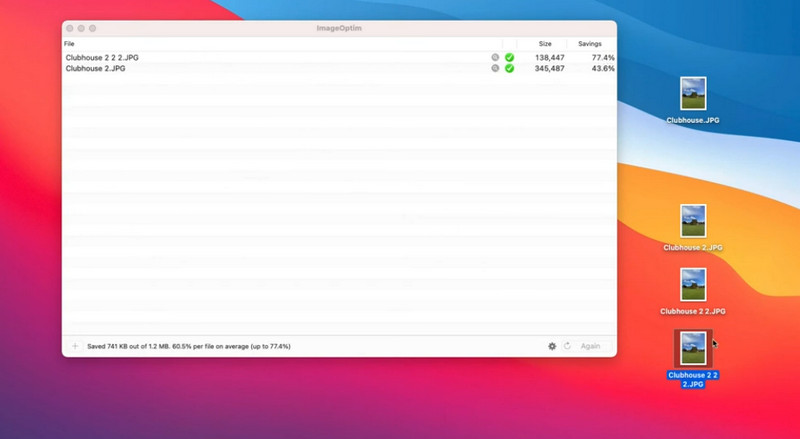
Part 4. FAQs about How to Compress JPG
Can JPEG files be compressed?
Yes, you can condense JPG or JPEG further. Usually with image editing software or online compression tools, which reduce file size at the cost of some image quality.
Are JPG and JPEG the same?
JPG and JPEG are essentially the same; the former arose from the three-character limit for file extensions in older versions of Windows, while JPEG is the acronym for the Joint Photographic Experts Group that created the standard.
How do I convert a photo to JPG?
To convert a photo to JPG, open it in an image editor, choose 'Save As' or 'Export,' select JPG or JPEG as the format, and save the new file. Online converters also offer a straightforward way to convert images to JPG without the need for software.
That is everything you need to know about how to compress a JPEG on Windows or Mac. Compressing JPEG photos is a must-do for web designers, photographers, and any digital aficionado looking to balance image quality with file size. By understanding the capabilities and functions of the various tools, you can make your images lean and web-ready without sacrificing their aesthetic appeal.

Reduce the file size of an image online within seconds while preserving the quality. We support JPG, PNG, WEBP, GIF, and more.
TRY NOW

